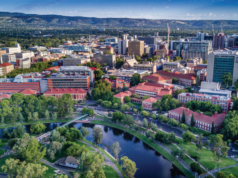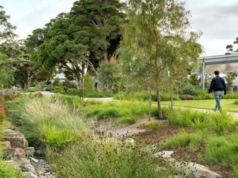‘Greening’ cities isn’t just about planting trees. Successful urban greening projects – which make cities more resilient to heatwaves, flooding and pollution, and contribute to improved community wellbeing – require the right leadership, planning and resources.
“Urban greenery is infrastructure – just like footpaths or streetlights,” says Thami Croeser, a research officer at the Centre for Urban Research at RMIT University in Melbourne. “Greenery supports our health by encouraging outdoor recreation – not just in parks, but also by making streets inviting to walk down. It’s also really important in managing urban heat and flooding.”
Many cities have set targets to increase urban greenspace. The London Environment Strategy, for example, aims to increase tree cover by 10 per cent of current levels – 8.4 million trees that cover around 21 per cent of the city’s land area – by 2050. The City of Sydney plans to increase the local area’s overall green cover to 40 per cent and its tree canopy to 27 per cent by 2050.
The science of greening cities
Greening cities isn’t as simple as planting more trees. “It’s all about the right trees, right spots and the right science,” writes Dr Samuel Yutong Cai, a senior environmental epidemiologist at Oxford University.
Some tree species release large amounts of pollen that cause hay fever. The sex of trees is another factor: street trees tend to be male, as female trees drop seeds, fruit and pods. Male trees, however, release more pollen.
Where to plant also matters, writes Cai. “Planting trees in a city street flanked by buildings will trap air pollution from the busy traffic under the tree canopy, exposing pedestrians and residents to dangerously high levels of air pollution.”
To avoid adverse outcomes to health and the environment, Cai says “decision-making should be informed through open discussions involving urban planners, plant scientists, atmospheric scientists, public health officials and local councils”.
Barriers holding back urban greening
Despite the consensus on the benefits of urban greenery, project implementation is often slow and inconsistent, and rarely lives up to expectations.
A recent report commissioned by the Australian Conservation Foundation found that most of Australia’s capital cities have lost tree cover in recent years. Hobart and Canberra were the only capital cities that had more vegetation in 2020 than in 2013.
RMIT University’s Croeser is one of the authors of a new study that found the most significant barriers to “nature-based solutions” are “understaffing, a lack of intra-organisational processes, and risk-averse organisational cultures”.
Underpinning these barriers is “a mismatch between ambition and capacity,” he says. “Cities are good at talking about greening, but delivery is where things fall short. Often this is because the processes and standards aren’t really in place to efficiently deliver greening; it’s often engineers that are left out of strategy development until it’s time to dig a hole or reclaim a traffic lane.
“The engineers I’ve worked with are usually excellent problem solvers and need to be part of the conversation earlier, so the solutions are in place before designs are drafted.”
Among the world’s best known urban greening projects are:
- Bosco Verticale, a pair of tree-covered residential towers in Milan;
- The High Line, a historic freight rail corridor in New York transformed into a two-kilometre-long public park;
- Cheonggyecheon, the site of a former highway in Seoul that the city redeveloped as a verdant urban waterway.
“Germany and Switzerland have had huge success with green roof incentives in their cities, creating thousands of hectares of green roof cover,” says Croeser. “Closer to home, the largest green roof in the southern hemisphere can be found on top of the Victorian desalination plant in Wonthaggi.”
Tips for successful urban greening
Croeser says these are the steps managers must take before embarking on any greening project:
- Talk to everyone with a role to play before you start. Design, legal, engineering, disability access, irrigation, horticulture, waste management… get everyone on board and build a common purpose, because these projects need close, constructive collaboration.
- Do thorough due diligence, especially on underground services but also above-ground uses like waste collection and emergency access.
- Budget for maintenance, make sure the maintenance is properly specified and don’t skimp on contractors or irrigation.
- Ideally, choose your site in partnership with the community – you want your locals to support the project.
- Expect challenges and barriers and expect to problem-solve around these barriers. There is almost always a work-around, so never give up.














